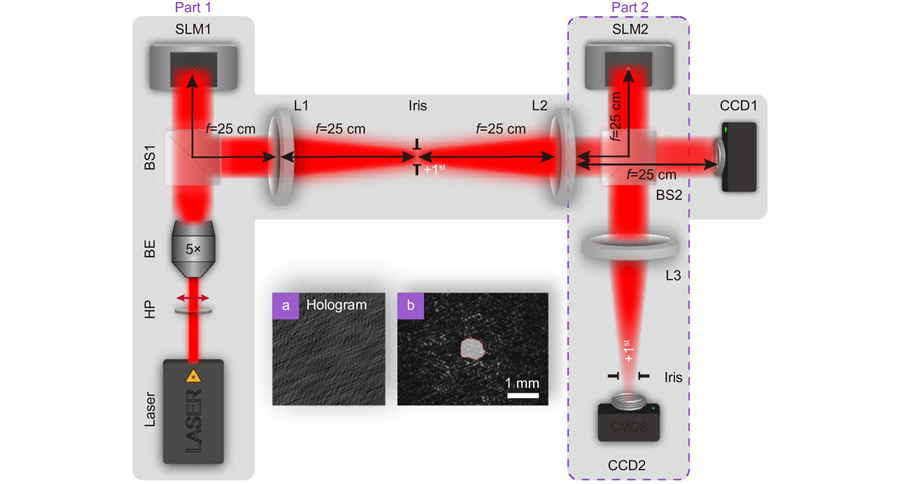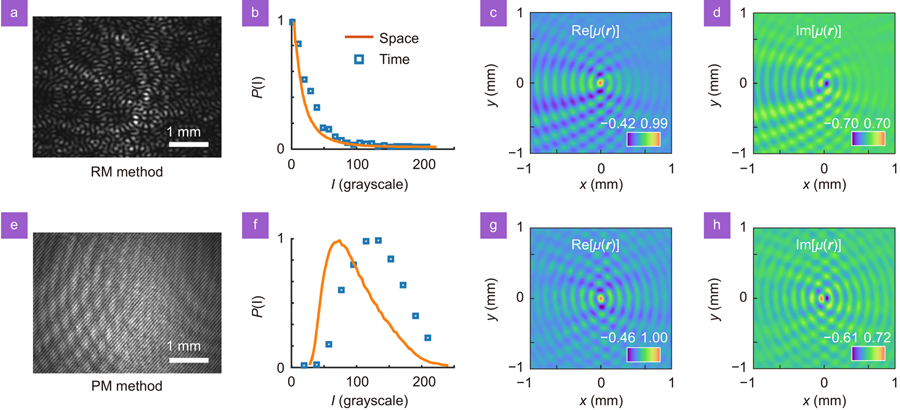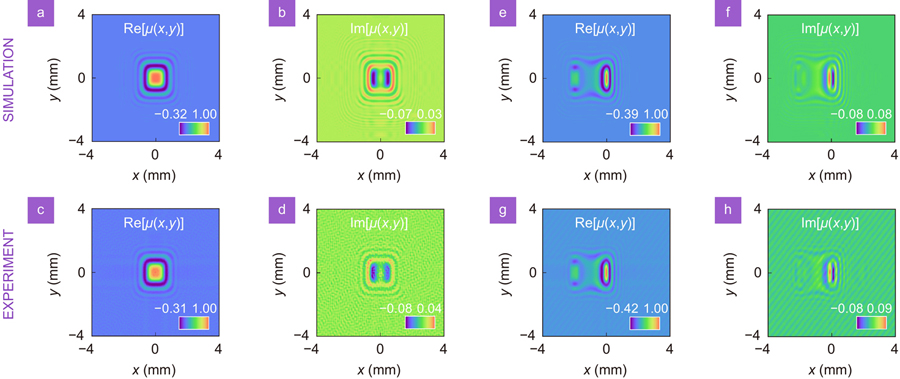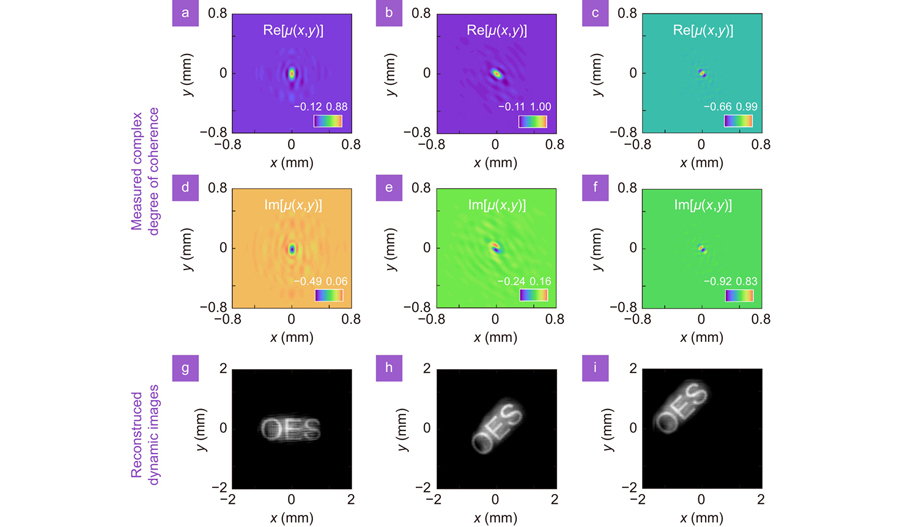Measurement of optical coherence structures of random optical fields using generalized Arago spot experiment
1 Introduction
The optical coherence structure, as one intrinsic property of a light beam, plays a pivotal role in not only optical interference but also a wide range of applications. The optical coherence theory provides a viable platform for studying partially coherent beams (PCBs)1, 2. Such beams are characterized by a cross-spectral density (CSD) function in the spatial-frequency domain or a mutual coherence function (MCF) in the spatial-time domain. PCBs, with the prescribed optical coherence structures, have various applications in optical coherence tomography3-5, optical communication6, phase imaging7-9, incoherent source reconstruction10, and super-resolution optical imaging11, 12; notably, they can be imaged through scatter media13. We recently proposed optical coherence imaging, wherein optical coherence structure, as the information carrier, could realize robust far-field optical imaging14-17. It can be immune to atmospheric turbulence and opaque obstacles. On the other hand, there are multifarious theoretical and experimental methods proposed to generate predetermined PCBs, with two techniques being the most popular. The first operates based on the van Cittert–Zernike theorem18, 19, employing a fully incoherent beam with the desired intensity profile via propagation. The other exploits the mode-superposition principle20-24, involving the coherent-mode, pseudo-mode (PM), and random-mode (RM) representations. Measuring the complex optical coherence structure is of great interest from both fundamental and application perspectives.
The optical coherence structure has traditionally been measured using Young’s interference experiment, wherein its magnitude and phase can be predicted based on the visibility and position of the fringes, respectively. However, this experiment only considers two light beam points. Full characterization of the optical coherence structure requires that each point be scanned independently across the beam plane, which requires significant time and effort. Improvements to this experiment have been proposed, such as non-parallel slits25, non-redundant arrays of pinholes26, and programmable slits/apertures based on spatial light modulators or digital micromirror devices27. Furthermore, signal interferometers28, wavefront-folding interferometers29, and other interference methods30 have been developed to measure optical coherence structures. These interferometric methods involve a complicated and misalignment- and vibration-sensitive setup and are difficult or infeasible to implement in some spectral regions. These problems can be solved using diffraction methods such as the phase-space approach31, diffraction from an opaque obstacle or a transparent mask with a phase discontinuity32, 33, or self-referencing holography8, 34, 35. However, the zero-order approximation of the Taylor series of illuminated PCBs is involved in these methods31-33. The authors34, 35 used a Dirac phase point as the perturbation point. Additionally, other methods such as the Hanbury Brown and Twiss (HBT) effect and generalized HBT effect have been proposed36, 37; they are only valid for beams with Gaussian statistics. Despite all the efforts, measuring both the real and imaginary parts of the optical coherence structure still remains an open and great challenge. Thus, in this letter, we have provided rigorous mathematical solutions and employed the classical optical diffraction experiment–the generalized Arago spot experiment38, wherein the transmittance function of the obstacle is complex, to fully recover the optical coherence structure of PCBs.
2 Theoretical derivation
Let us consider a scalar, quasi-monochromatic, and statistically stationary random optical field
where
where
In our protocol, we adopted the classical optical diffraction experiment— the Arago spot experiment, wherein the beam is obstructed by an obstacle in the source plane and captured in the Fraunhofer zone. We used the Huygens-Fresnel principle to study the beam intensity in the observation plane:
where
By substituting
and
respectively, with
From
The observation plane was in the Fraunhofer zone, so the response function of the optical system had a Fourier structure;
where the tilde denotes the Fourier transform;
To simplify
where
We concluded from
To generate the PCBs with the specific optical coherence structures in the experiment and simulation, we employed the mode- superposition principle to realize it in this study. First, we briefly introduced the RM method39. According to the coherence theory, the optical coherence structure can be rewritten as18:
where
with
where
To demonstrate the feasibility of our protocol for PCBs with different optical statistics, we followed23, 40 and adopted the PM method. The optical coherence structure is expressed below, which is the discrete form of
where
In both methods,
In the simulation, we could first create a set of modes in the source plane by the above equations. Then, the mode obstructed by an obstacle is captured in the Fraunhofer zone. As illustrated by
where the
3 Experimental demonstration

Fig. 1. Schematic of an experimental setup for generation (part 1) and measurement (part 2) of the complex optical coherence structures of random optical fields. (a ) Example of the computer-generated holograms loaded on the screen of SLM1, which is used to customize the complex spatial optical coherence structure of the random optical fields. (b ) An instantaneous speckle intensity captured by the CCD1 camera, wherein the irregular area denotes an obstacle. HP, half-wave plate; BE, beam expander; BS1 and 2, beam splitters; SLM1 and 2, phase-only spastial light modulators; L1–3, thin lenses with same focal length f=25 cm; CCD1 and 2, charge-coupled devices. The irises are used to select the positive (or negative) 1st diffraction beam; The CCD1 and CCD2 cameras are used to capture the individual mode intensity patterns in the source plane and the Fourier plane, respectively.
where
We first considered Schell-model PCBs subjected to Gaussian statistics. To illustrate the robustness of this protocol, we followed the RM method [see
![(a–c) Simulation and (d–f) experimental results for the [(a) and (d)] real part; [(b) and (e)] imaginary part; and the [(c) and (f)] square of the modulus of the optical coherence structure functionμ(Δr) of the complex partially coherent beam. The letter “A” is adopted as the power spectrum density function P(κ), and K(r, κ) = exp (−i2πr·κ). Such a partially coherent beam has been produced by the RM method in the experiment, and an irregular obstacle has been chosen, as shown in Fig. 1 (b).](/richHtml/oes/2023/2/2/220024/2_oes-2022-0024CaiYangjian-2.jpg)
Fig. 2. (a –c ) Simulation and (d –f ) experimental results for the [(a) and (d)] real part; [(b ) and (e )] imaginary part; and the [(c) and (f)] square of the modulus of the optical coherence structure functionμ(Δr ) of the complex partially coherent beam. The letter “A” is adopted as the power spectrum density function P(κ ), and K(r , κ ) = exp (−i2πr ·κ ). Such a partially coherent beam has been produced by the RM method in the experiment, and an irregular obstacle has been chosen, as shown in Fig. 1 (b).
Next, we shall describe how this protocol is also applicable to Schell-model PCBs with non-Gaussian statistics. As suggested by the PM method in

Fig. 3. Experimental results for the same partially coherent Schell-model beams with different optical statistics. In the upper (a –d ) and lower (e –h ) rows, they have Gaussian (produced by RM method) and non-Gaussian (produced by PM method) statistics, respectively. (a) and (e) show the individual RM and PM patterns, respectively; (b ) and (f ) show the experimentally measured intensity PDF curves in space and time. The beam intensity captured by the CCD camera is saved as a grayscale image. The magnitude of grayscale value represents the intensity value of the beam. The spatial intensity PDF is obtained by calculating the gray value of all pixels of a single mode pattern image (consisting of 1288×964 pixels). The temporal intensity PDF is obtained by calculating the gray value of all mode patterns (refreshed by time) at the fixed spatial position; (c, d, g, h) show the experimentally measured real and imaginary parts of the complex optical coherence structures.
For a non-Schell-model PCB, that is, a PCB with a non-uniformly correlated function45, the optical coherence structure is highly sensitive to the reference point position. We applied
where

Fig. 4. Simulation (upper row) and experimental (lower row) results for the optical coherence structures of the non-Schell-model partially coherent beams subjected to non-Gaussian statistics, with the reference point positions (a –d ) r0= (0 mm, 0 mm) and (e –h ) r0 = (1 mm, 0 mm). In the experiment, such a partially coherent beam has been produced by the PM method, and the Dirac obstacle has been replaced by a circular obstacle with a radius of 0.15 mm.
Finally, we shall show our protocol can be highly used in the optical coherence structure related applications, and can be conducive to rapid improvement of application efficiency. We took one example - optical coherence encryption protocol proposed by Peng et al17. In that work, they used a generalized HBT method for this application, which must take a lot of time for doing speckles statistics to recover a single image. Here we displayed that the proposed protocol can decrypt the dynamic images (or a video). Regarding the encryption technique, they followed

Fig. 5. Experimentally recovered optical coherence structures and decrypted dynamic images. (a –c ) Real and (d –f ) imaginary parts of the optical coherence structures are reconstructed by our measurement protocol. (g –i ) Corresponding instantaneous recovered images from the optical coherence structures.
4 Conclusion
In this study, we propose a robust, convenient, and fast technique to measure the optical coherence structures of random optical fields using a classical optical diffraction experiment—the generalized Arago spot experiment. We have provided rigorous mathematical solutions and presented them in extremely simplified analytical expressions based on different beam types; these solutions are applicable to any genuine PCB subjected to different optical statistics. Regarding the Schell-model PCBs common in laboratories, our protocol is valid for any obstacle, regardless of its shape, size, and location. Regarding the non-Schell-model type (i.e., non-uniformly correlated PCBs), the Dirac pinhole was adopted as the obstacle, and the location of the obstacle determined the reference point position of the degree of coherence function. In the experiment, it was necessary to capture the far-zone intensity only three times, and after simple calculations, we could precisely recover the real and imaginary parts of the complex optical coherence structures. The experimental results perfectly agreed with the simulation ones. They well indicate our protocol has simplicity, high efficiency, and precision. We believe that our proposal will shed new light on phase measurement, optical imaging, and other applications.
5 Acknowledgements
This work was supported by the National Key Research and Development Program of China (2022YFA1404800, 2019YFA0705000), National Natural Science Foundation of China (11974218, 12004220, 12104264, 12192254, 92250304), Regional Science and Technology Development Project of the Central Government (YDZX20203700001766), China Postdoctoral Science Foundation (2022T150392), and the Natural Science Foundation of Shandong Province (ZR2021QA014, ZR2021ZD02).
X. Liu and Q. Chen completed the theoretical model and performed the experiments. J. Zeng conducted the analysis and prepared the manuscript. C. H. Liang proposed the original idea. Y. J. Cai supervised the work. All the authors discussed and analyzed the results and commented on the manuscript at all stages.
The authors declare no competing financial interests.
[1] Mandel L, Wolf E. Optical Coherence and Quantum Optics (Cambridge University Press, Cambridge, 1995).
[19] Cai YJ, Chen YH, Wang FGeneration and propagation of partially coherent beams with nonconventional correlation functions: a review [Invited]J Opt Soc Am A20143120832096
[38] Rennie R. A Dictionary of Physics 7th ed (Oxford University Press, New York, 2015).
[41] Schmidt JD. Numerical Simulation of Optical Wave Propagation with Examples in MATLAB (SPIE, Bellingham, 2010).
[42] Rosales-Guzmán C, Forbes A. How to Shape Light with Spatial Light Modulators (SPIE, Bellingham, 2017).
Article Outline
Xin Liu, Qian Chen, Jun Zeng, Yangjian Cai, Chunhao Liang. Measurement of optical coherence structures of random optical fields using generalized Arago spot experiment[J]. Opto-Electronic Science, 2023, 2(2): 220024.



